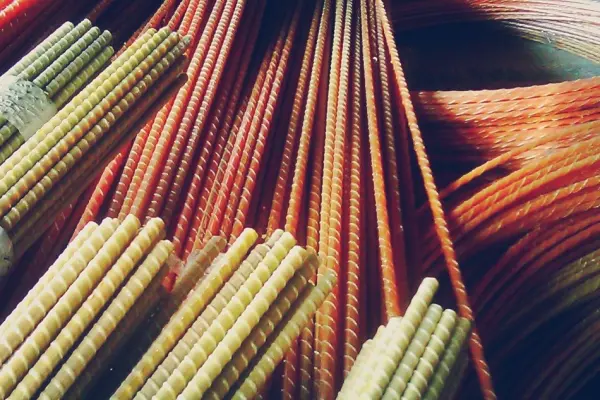Fiberglass rebar is rapidly gaining ground in the construction materials market. This modern material offers practical solutions for reinforcing various structures. According to analytical reports, the global composite rebar market was valued at $0.8 billion in 2023 and is forecasted to grow to $1.5 billion by 2030. The current average price per linear meter of such rebar ranges from $0.5 to $2. This interest is quite understandable. Frankly speaking, the use of fiberglass rebar opens new possibilities for builders and designers, especially under increasing requirements for durability and environmental friendliness of structures.
Why are more and more professionals paying attention to composite rebar? Let's examine the characteristics of this material, its advantages, and areas of application in 2025 construction. Not everyone knows that fiberglass reinforcement can significantly extend the service life of structures and reduce their maintenance costs. Are you ready to reconsider traditional approaches to reinforcement in favor of more modern solutions?
What is Fiberglass Rebar and Its Main Characteristics
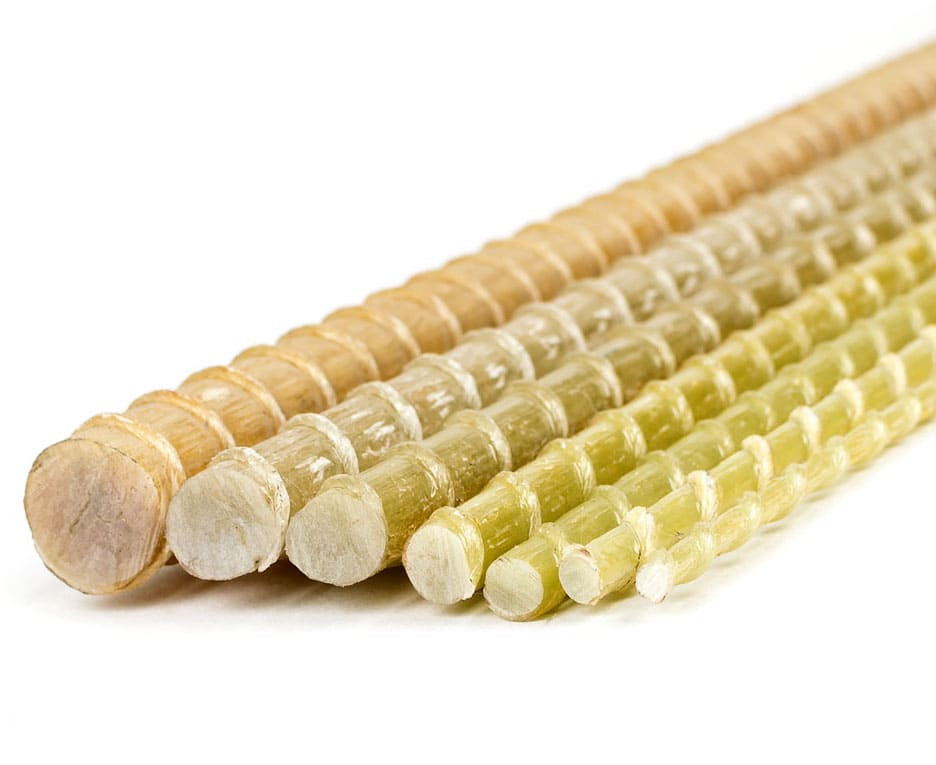 Fiberglass rebar (also known as composite rebar) consists of glass fiber rods impregnated with a polymer binder. Glass fiber in construction is used not only for reinforcement but for other purposes as well. This material appeared on the market relatively recently but has already established itself as an effective alternative to metal rebar for concrete.
Fiberglass rebar (also known as composite rebar) consists of glass fiber rods impregnated with a polymer binder. Glass fiber in construction is used not only for reinforcement but for other purposes as well. This material appeared on the market relatively recently but has already established itself as an effective alternative to metal rebar for concrete.
The production of fiberglass rebar is regulated by the international standard ISO 10406-1:2015 "Fibre-reinforced polymer (FRP) reinforcement of concrete — Test methods," which establishes testing methods and requirements for composite rebar. In Ukraine and CIS countries, GOST 31938-2012 "Polymer composite reinforcement for concrete structures" is also applied, while in the USA, the standard ACI 440.1R-15 "Guide for the Design and Construction of Structural Concrete Reinforced with FRP Bars" is used. GOST 31938-2012 and international standards have some differences in requirements, but the general principles are similar. Each element has a periodic profile, ensuring reliable adhesion with concrete — like gear teeth meshing together. This is critically important for ensuring the strength of reinforced structures.
When designing structures using fiberglass rebar, it's important to consider its characteristics. Never replace metal rebar with composite mechanically, based solely on equal diameter. Use equal-strength replacement tables or consult with specialists. Proper calculation will ensure both economy and safety of your structure.
Types of Composite Rebar: Differences and Application Areas
 Composite rebar is presented on the market in several varieties, each with its own characteristics and application areas. Understanding the differences between them will help make the right choice for a specific project. On one of the construction forums, I noticed that many people still confuse different types of composite rebar, considering them identical in characteristics.
Composite rebar is presented on the market in several varieties, each with its own characteristics and application areas. Understanding the differences between them will help make the right choice for a specific project. On one of the construction forums, I noticed that many people still confuse different types of composite rebar, considering them identical in characteristics.
| Type of Rebar | Main Material | Characteristics | Optimal Application Areas |
|---|---|---|---|
| Fiberglass (GFRP) | Glass fiber | Optimal price/quality ratio, good strength, low thermal conductivity | Foundations, walls, floors, low-rise construction |
| Basalt fiber (BFRP) | Basalt fiber | Enhanced heat resistance (up to 400°C), alkali resistance | Structures with increased fire resistance requirements, chemically aggressive environments |
| Carbon fiber (CFRP) | Carbon fiber | Maximum strength, high elasticity modulus, lower deformability | Highly loaded structures, bridge construction, reinforcement of existing buildings |
| Aramid fiber (AFRP) | Aramid fiber | High resistance to impact loads and vibration | Earthquake-resistant structures, facilities with dynamic loads |
Fiberglass rebar (GFRP) is the most common and economically accessible type of composite rebar, making it the optimal choice for most standard construction projects. It's like a universal soldier in the army of construction materials – it handles most tasks at a moderate cost. Basalt fiber rebar, on the contrary, is similar to a special unit designed for particularly difficult conditions, where increased resistance to high temperatures and aggressive chemical influences is required.
The production process of fiberglass rebar includes several stages. First, the glass fiber is impregnated with a binding substance. Then the rod of the required diameter is formed. The final stage – applying a spiral winding to the surface to create a periodic profile. Depending on the manufacturer, the technology may differ somewhat, but the basic principles remain unchanged.
Technical Characteristics of Fiberglass Rebar
The technical characteristics of fiberglass rebar determine the possibilities of its application in various structures. In my experience, understanding these parameters helps make the right decision about the feasibility of using this material in a specific project.
| Characteristic | Fiberglass Rebar | Metal Rebar (Class A-III) |
|---|---|---|
| Tensile strength | 800-1300 MPa | 390-500 MPa |
| Elasticity modulus | 50-55 GPa | 200 GPa |
| Coefficient of linear expansion | 9-12×10⁻⁶/°C | 13-15×10⁻⁶/°C |
| Density | 1.9 g/cm³ | 7.85 g/cm³ |
| Corrosion resistance | Not subject to corrosion | Subject to corrosion |
| Thermal conductivity | 0.35-0.5 W/m·°C | 46-56 W/m·°C |
| Electrical conductivity | Dielectric | Conductor |
| Relative elongation at break | 2.2% | 25% |
This table clearly demonstrates the key differences between fiberglass and metal rebar. As we can see, composite rebar significantly surpasses metal in tensile strength and corrosion resistance, while having substantially less weight. The elasticity modulus of fiberglass rebar can be compared to a spring made of composite material — it is less rigid than a steel spring but can withstand greater tensile force without destruction.
At the international level, the technical characteristics of fiberglass rebar are regulated by the standard ASTM D7957/D7957M-17 "Standard Specification for Solid Round Glass Fiber Reinforced Polymer Bars for Concrete Reinforcement", which defines the requirements for strength, durability, and other parameters of fiberglass rods.
Chemical Resistance of Fiberglass Rebar
The chemical resistance of fiberglass rebar deserves special attention, making it irreplaceable in aggressive environments. Unlike metal, fiberglass is practically not affected by most chemical substances, which significantly expands its scope of application. By the way, in my practice, I have repeatedly observed how metal rebar was destroyed after just 5-7 years in conditions of high humidity and exposure to salts.
According to research conducted by the American Concrete Institute (ACI), fiberglass rebar demonstrates high resistance to the following environments:
- Acids – resistant to most organic and inorganic acids of medium concentration
- Alkalis – maintains properties when in contact with alkaline solutions (when using appropriate types of resins)
- Salt solutions – ideal for marine structures and facilities in coastal zones
- Petroleum products – resistant to most hydrocarbons
- Chlorides – not subjected to the destructive effects of chlorides, unlike steel rebar
This makes fiberglass rebar the optimal choice for the construction of water treatment facilities, chemical plants, marine and coastal facilities, as well as road infrastructure where anti-icing reagents are used. According to the International Federation for Structural Concrete (fib), the service life of structures with composite rebar in aggressive environments can exceed the service life of similar structures with metal rebar by 2-3 times.
Advantages of Using Fiberglass Rebar in Construction
Construction using composite rebar has a number of significant advantages. Last season, I faced the need to choose the optimal material for reinforcing the foundation of a country house in conditions of high humidity and high groundwater levels. Fiberglass rebar proved to be the ideal solution. Let's examine in more detail what advantages this material provides.
Advantages of fiberglass rebar in construction:
- High corrosion resistance — does not rust even in aggressive environments, which is especially important when reinforcing foundations with fiberglass rebar in conditions of high humidity.
- Light weight — 4-5 times lighter than metal rebar, which simplifies transportation and installation. A coil of 8 mm diameter rebar with a length of 100 m weighs only about 15 kg.
- High tensile strength — exceeds metal rebar by 2-3 times, which allows the use of smaller diameter rods.
- Low thermal conductivity — 100 times lower than steel, which eliminates the formation of "cold bridges" in structures.
- Dielectric properties — does not conduct electrical current, which is important for facilities with sensitive electronic equipment.
- Durability — the estimated service life of composite rebar is over 80 years without loss of properties.
- Environmental friendliness — production requires less energy than steel smelting, and the material is recyclable.
- Availability of raw materials — the main component is quartz sand, the reserves of which on the planet significantly exceed the reserves of iron ore, ensuring long-term stability of production and supply.
These advantages make fiberglass rebar particularly attractive for reinforcement in low-rise construction, as well as in structures operated in aggressive environments. But the list of its merits doesn't end there.
When working with fiberglass rebar, it's important to remember its properties. For cutting, use an angle grinder with an abrasive disc, not a hacksaw or axe. When creating a frame, use special plastic fasteners or tie wire. Make connections with an overlap of 20-50 cm, depending on the diameter and operating conditions. These simple recommendations will allow you to get the maximum benefit from using composite rebar.
Disadvantages and Limitations of Fiberglass Rebar
Despite its many advantages, fiberglass rebar has a number of disadvantages and limitations that need to be considered in design and construction. An objective understanding of these limitations will help avoid potential problems and disappointments.
Main disadvantages and limitations of fiberglass rebar:
- Low elasticity modulus — approximately 4 times lower than steel, which can lead to larger deformations of structures under prolonged loads.
- Limited heat resistance — fiberglass rebar begins to lose strength characteristics at a temperature of about 200°C, which limits its use in structures with high fire resistance requirements.
- Inability to bend on-site — unlike metal, fiberglass cannot be bent without special equipment, which requires ordering pre-bent elements from production.
- Sensitivity to ultraviolet — prolonged exposure to direct sunlight can reduce the strength characteristics of the material.
- Height limitations — due to the low elasticity modulus, it is not recommended for use in high-rise buildings and structures without additional calculations and special technical solutions.
- Absence of plastic deformations — fiberglass breaks brittlely, without preliminary deformations, which can be critical under dynamic loads.
To minimize these disadvantages, it is recommended to:
- Increase the protective layer of concrete to enhance the fire resistance of the structure
- Apply combined reinforcement (fiberglass + metal) in critical structures
- Use special anti-UV additives or ensure protection of the rebar from sunlight during storage
- Perform calculations taking into account the rheological properties of the material and possible deformations
With the right approach to design and adherence to installation technology, most of these limitations can be successfully overcome, obtaining the maximum benefit from using fiberglass rebar.
Environmental Aspects and Energy Efficiency of Composite Rebar
In 2025 construction, environmental aspects and energy efficiency of the materials used are gaining increasing importance. Fiberglass rebar offers significant advantages in these areas, making it an attractive choice for environmentally responsible construction. It can be surprising how one component of a structure can so significantly affect the overall energy efficiency of a building, like a bridge between comfort and economy.
According to research by the World Green Building Council (WGBC), the use of composite rebar allows reducing the carbon footprint of a building for the following reasons:
- Energy savings in production — producing fiberglass rebar requires 30-40% less energy than producing an equivalent amount of metal rebar.
- Reduction of transport emissions — due to its lower weight, transporting composite rebar requires less fuel and creates fewer CO₂ emissions.
- Increasing energy efficiency of buildings — the low thermal conductivity of fiberglass (100 times lower than steel) significantly reduces heat loss through "cold bridges" in reinforced structures, which can reduce the cost of heating a building by 5-15% depending on climatic conditions.
- Durability and reduced need for repair — longer service life means fewer repairs and reconstructions, which also reduces the overall environmental impact throughout the life cycle of the building.
- Recyclability — fiberglass waste can be recycled and used in the production of new building materials, reducing the amount of construction waste.
The European Energy Performance of Buildings Directive (EPBD) emphasizes the importance of minimizing thermal bridges in building structures. The use of fiberglass rebar in exterior walls and floor slabs can be an effective solution to meet these requirements. According to expert estimates, the reduction of heat loss through reinforced structures can reach 10-20 kWh/m² per year, which is especially significant for energy-efficient and passive houses.
The use of energy-efficient materials, such as fiberglass rebar, is becoming not just a fashionable trend, but a necessity in the context of rising energy prices and tightening environmental requirements for construction.
Areas of Application for Fiberglass Rebar
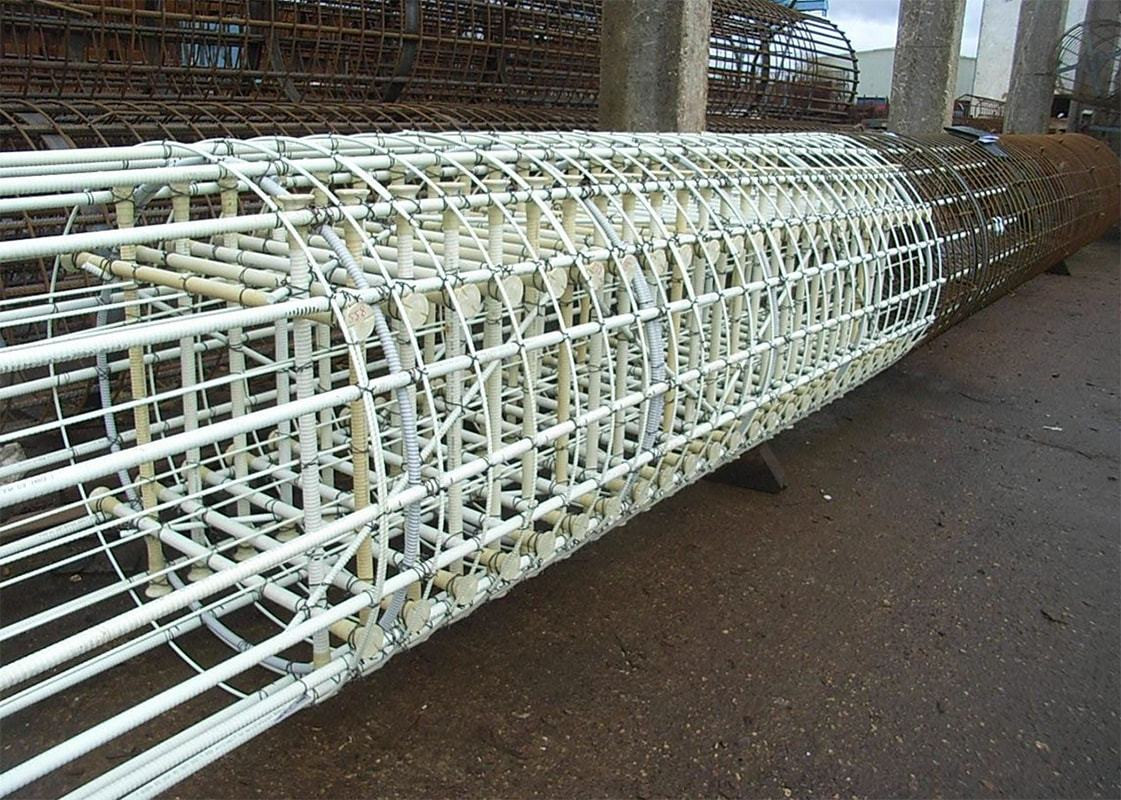 Fiberglass reinforcement is in demand in various areas of construction. The versatility of this material, like a Swiss army knife for builders, allows it to be used in a wide variety of structures. Each project is unique, but there are a number of typical solutions where the use of fiberglass rebar is most effective.
Fiberglass reinforcement is in demand in various areas of construction. The versatility of this material, like a Swiss army knife for builders, allows it to be used in a wide variety of structures. Each project is unique, but there are a number of typical solutions where the use of fiberglass rebar is most effective.
Main areas of application for fiberglass rebar:
- Foundation reinforcement with fiberglass rebar — especially effective for strip and slab foundations in low-rise construction.
- Reinforcement of walls and partitions — allows increasing the thermal insulation properties of the structure.
- Reinforcement of concrete floors and screeds — ensures durability and absence of corrosion when in contact with moisture.
- Reinforcement of floor slabs — in combination with metal rebar to ensure the necessary rigidity.
- Road construction — for reinforcing structures in road construction, especially in places where anti-icing reagents are applied.
- Hydraulic structures — thanks to resistance to corrosion and the effects of seawater.
- Production of flexible ties from composite — for multi-layer walls and facade systems.
Reinforcement of structures in road construction using fiberglass rebar is becoming particularly relevant. Traditionally used metal rebar in road slabs and bridge structures is subject to intensive corrosion due to the effects of anti-icing reagents and atmospheric factors. Composite rebar completely solves this problem, increasing the service life of road structures by 2-3 times.
In each of these areas, the application of fiberglass rebar has its own characteristics and requires adherence to certain technologies. Not always simple. But effective.
Research conducted by international specialists confirms the effectiveness of composite materials in bridge construction. An overview of the application of fiber-reinforced polymers in bridge construction shows that these materials are becoming increasingly popular due to their superior properties, including lightness, strength, durability, and resistance to corrosion.
Construction Using Composite Rebar: Practical Examples
The application of fiberglass rebar in real projects demonstrates its advantages most clearly. Let's consider several practical examples illustrating the effectiveness of this material.
"In 2020, we implemented a project for a country house using fiberglass rebar for reinforcing the foundation and walls. The main problem was a high level of groundwater and an aggressive environment. The choice fell on composite rebar due to its resistance to corrosion and long service life. As a result, we saved about 20% on materials and logistics compared to the traditional solution. Now, four years later, the structure is in perfect condition, with no signs of destruction or deformation. An additional bonus was the improvement of the thermal insulation properties of the building due to the absence of 'cold bridges'. This experience convinced us of the advantages of composite rebar, and now we recommend it for most of our low-rise construction projects."
— Alexey Kravchenko, Chief Engineer of the construction company "KingDom"
Similar examples from real practice confirm that fiberglass reinforcement is not just a theoretical concept, but a working solution that already helps build more quality and durable buildings and structures today. When ordering fiberglass rebar for your project, pay attention to conformity certificates — they guarantee the quality of the material.
Calculation Example for a Typical Project
For clarity, let's consider a simplified calculation example of fiberglass rebar for a strip foundation of a country house with dimensions of 10×10 m. These calculations will help understand exactly how much material needs to be purchased and what the approximate costs are.
Initial data:
- House size: 10×10 m
- Width of strip foundation: 40 cm
- Height of foundation: 60 cm
- Reinforcement: in two belts (upper and lower)
- Step of longitudinal rods: 20 cm
- Step of transverse rods: 40 cm
Calculation for fiberglass rebar with a diameter of 8 mm:
- Perimeter of the foundation: (10 + 10) × 2 = 40 m
- Number of longitudinal rods in one belt: 3 pcs. (across the width of the foundation)
- Total length of longitudinal rods: 40 m × 3 pcs. × 2 belts = 240 m
- Number of transverse rods: 40 m ÷ 0.4 m = 100 pcs.
- Average length of one transverse rod: 0.4 m
- Total length of transverse rods: 100 pcs. × 0.4 m = 40 m
- Total fiberglass rebar needed: 240 m + 40 m = 280 m
- Taking into account overlaps and waste (coefficient 1.1): 280 m × 1.1 = 308 m
With an average cost of fiberglass rebar with a diameter of 8 mm at $0.8 per linear meter, the total cost for rebar will be: 308 m × $0.8 = $246.4
For comparison, an equivalent amount of metal rebar with a diameter of a 10 mm (by equal-strength replacement) will weigh approximately 4 times more and cost around $320-350, not counting additional costs for transportation, cutting, and tying of the heavier material.
This example demonstrates that using fiberglass rebar allows saving about 25-30% on material and reducing labor costs for installation due to lower weight. When ordering fiberglass rebar in bulk, manufacturers may provide additional discounts, and the packaging of rebar in coils is convenient for transportation and storage.
Comparison of Fiberglass and Metal Rebar
When choosing rebar for construction, it's important to understand the key differences between fiberglass and metal rebar. By the way, many builders face the need for such a choice, and often the decision is made based on outdated ideas rather than objective analysis. At a construction forum in Kyiv, I noticed that many specialists still skeptically regard the replacement of metal rebar with composite, despite the obvious advantages of the latter in certain conditions.
| Parameter | Fiberglass Rebar | Metal Rebar | Advantage |
|---|---|---|---|
| Material cost | Higher | Lower | Metal |
| Transportation cost | Lower (lighter) | Higher (heavier) | Fiberglass |
| Corrosion resistance | High | Low | Fiberglass |
| Tensile strength | Higher | Lower | Fiberglass |
| Elasticity modulus | Lower | Higher | Metal |
| Heat resistance | Up to 200°C | Above 600°C | Metal |
| Service life | Over 80 years | 30-50 years | Fiberglass |
| Environmental friendliness | High | Medium | Fiberglass |
This comparison shows that each type of rebar has its own advantages and disadvantages. The replacement of metal rebar with fiberglass should be done taking into account the characteristics of each material. The choice depends on the specific requirements of the project, operating conditions, and economic factors.
Economic Efficiency of Using Fiberglass Rebar
Analyzing the economic efficiency of using composite rebar, it's necessary to consider not only the direct costs of purchasing the material but also the long-term benefits of its use. Fiberglass reinforcement can be more profitable than it seems at first glance. If you've decided to buy fiberglass rebar, it's worth considering the whole complex of factors affecting the final cost of the project.
| Economy Factor | Fiberglass Rebar | Metal Rebar | Savings |
|---|---|---|---|
| Material cost (per ton) | $1500-2000 | $800-1200 | -100% |
| Material consumption (ratio) | 1 | 2.5-3 | +150-200% |
| Transportation costs | Low | High | +60-70% |
| Installation costs | Low (light weight) | High (special equipment required) | +40-50% |
| Anti-corrosion protection | Not required | Required | +100% |
| Repair within 50 years | Not required | 1-2 times | +100% |
| Thermal insulation properties | High | Low | +15-20% |
| Total savings over the entire life cycle | - | - | +25-40% |
This table demonstrates that despite the higher initial cost of fiberglass rebar, the overall savings when considering all factors can reach 25-40%. The savings are especially significant in construction in aggressive environments, where the service life of metal rebar is substantially reduced.
When looking for where to buy fiberglass rebar, pay attention to manufacturers offering comprehensive solutions, including delivery and technical consultations. Many manufacturers of fiberglass rebar offer the sale of composite rebar both wholesale and retail, allowing you to select the optimal solution for your project.
According to expert estimates, the use of fiberglass rebar in private construction can reduce the overall costs of reinforcement by 25-40%, given proper design and installation.
Technologies for Reinforcing Various Structures with Fiberglass Rebar
Proper fiberglass reinforcement requires knowledge of certain technologies and adherence to technical standards. In 2025, an update of standards is expected, which will take into account the latest research in the field of composite materials. For different types of structures, there are specific features of applying fiberglass rebar for concrete.
Foundation Reinforcement with Fiberglass Rebar
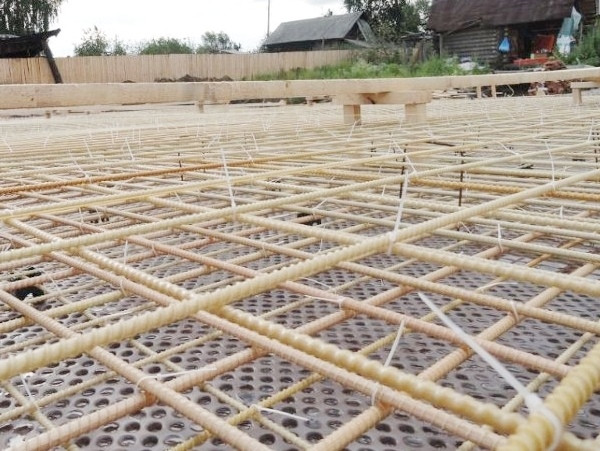 Foundation reinforcement is one of the main areas of application for fiberglass rebar. Composite rebar is especially effective in conditions of aggressive environments and increased soil moisture. This approach to construction ensures a long service life of the foundation.
Foundation reinforcement is one of the main areas of application for fiberglass rebar. Composite rebar is especially effective in conditions of aggressive environments and increased soil moisture. This approach to construction ensures a long service life of the foundation.
Main stages of foundation reinforcement with fiberglass rebar:
- Preparation of the base and arrangement of a sand cushion.
- Installation of formwork.
- Installation of the first layer of reinforcement mesh with a step of 15-20 cm.
- Installation of spacers to create a protective layer of concrete.
- Installation of the second layer of reinforcement mesh (if necessary).
- Connecting the rods with special clamps or tie wire.
- Pouring concrete and compacting it.
When designing a foundation using fiberglass rebar, consider its characteristics. Increase the protective layer of concrete to 3-4 cm to enhance the fire resistance of the structure. Use rebar with a diameter 2-4 mm smaller than when calculating with metal, but be sure to check compliance using tables of equal-strength replacement. When reinforcing a strip foundation, add additional rods in places of concentrated loads and at corners.
When designing, it's necessary to be guided by international standards, such as ACI 440.5-08 "Specification for Construction with Fiber-Reinforced Polymer Reinforcing Bars," which defines the requirements for the use of composite rebar when reinforcing various concrete structures. In CIS countries, GOST 31938-2012 is also applied, regulating the requirements for composite rebar for concrete.
Reinforcement of Floor Slabs and Concrete Floors with Fiberglass Rebar
Reinforcement of floor slabs with fiberglass rebar requires a special approach due to the low elasticity modulus of the material. For such structures, combined reinforcement is often used — fiberglass in the lower zone (for tension) and metal rebar in the upper zone (for compression). Is it possible to combine fiberglass and metal rebar? Yes, and in some cases, it is even recommended to achieve optimal characteristics of the structure.
When reinforcing concrete floors, fiberglass rebar is especially effective in conditions of moisture and aggressive environments. In this case, the technology of structural reinforcement includes laying a reinforcement mesh with a step of 15-20 cm and a rod diameter of 6-8 mm, depending on the expected loads.
According to the standard ASTM C1116/C1116M "Standard Specification for Fiber-Reinforced Concrete", the use of fiberglass rebar in concrete floors increases their resistance to impact loads and reduces the likelihood of crack formation.
Reinforcement of Walls and Columns with Fiberglass Rebar
The use of fiberglass rebar for reinforcing walls and columns has its own characteristics. In this case, it's important to ensure the correct placement of the rebar and its reliable connection with other elements of the structure.
The technology of wall reinforcement includes:
- Installation of vertical rods with a step of 30-40 cm.
- Installation of horizontal rods with a step of 20-30 cm.
- Connection of the rebar at intersection points.
- Installation of embedded parts for attaching other elements.
For columns, it is recommended to use combined reinforcement or completely metal rebar due to the need to ensure high rigidity of the structure.
When designing, it's necessary to be guided by the standard CSA S806-12 "Design and Construction of Building Structures with Fibre-Reinforced Polymers," which contains recommendations for the use of composite rebar in various types of structures.
Prestressed Structures with Composite Rebar
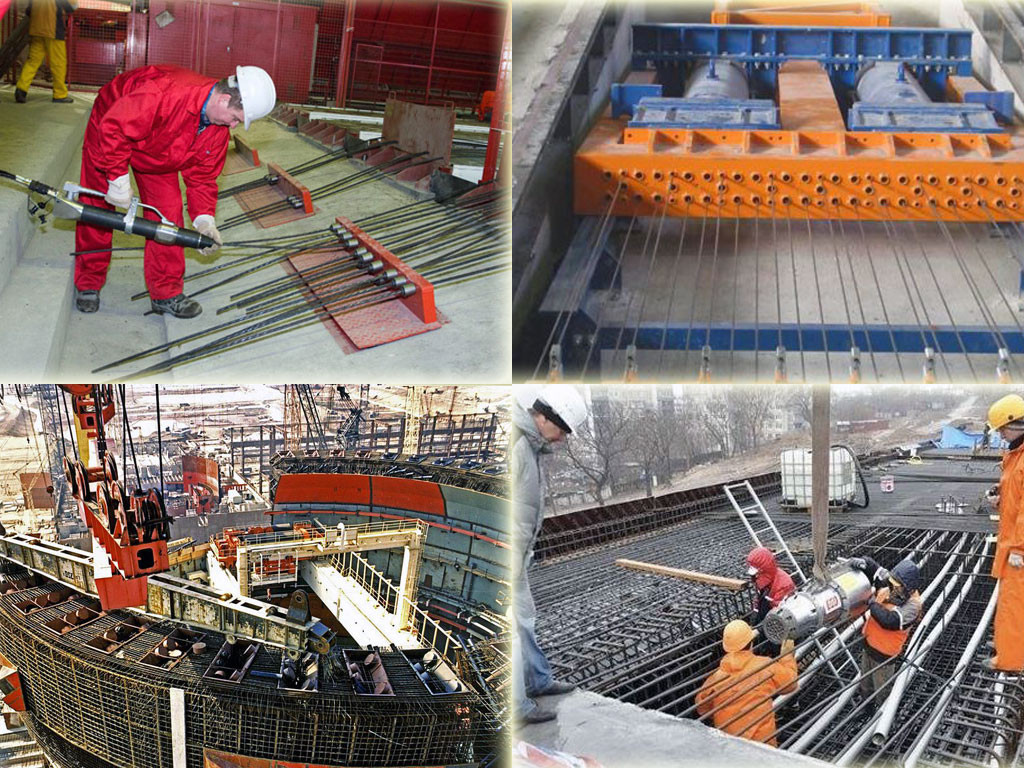 The use of fiberglass rebar for prestressed structures is a relatively new and promising area. Unlike steel, composite rebar has a higher tensile strength, which allows creating more effective prestressed elements.
The use of fiberglass rebar for prestressed structures is a relatively new and promising area. Unlike steel, composite rebar has a higher tensile strength, which allows creating more effective prestressed elements.
Features of using composite rebar in prestressed structures:
- Possibility of creating greater prestress due to the high strength of the material
- Absence of corrosion even with microcracks in the concrete
- Reduction of the overall weight of the structure
- The need to account for the characteristics of the elasticity modulus and stress relaxation
The technology of using composite rebar in prestressed structures is regulated by international standards and requires special calculations taking into account the characteristics of the material.
Global Experience in the Application of Fiberglass Rebar
The global experience in the application of fiberglass rebar spans several decades. North America accounts for 35% of the market thanks to demand for infrastructure projects, while Asia, especially China and India, shows the fastest growth (12% per year). In 2024, in the USA, fiberglass rebar accounted for 5% of the total rebar market, but in some countries, such as Canada, this figure reaches 10% for bridge structures.
Interesting examples of using fiberglass rebar in global practice:
- The Joffre Bridge in the Canadian province of Quebec (2006) — one of the first major bridges fully reinforced with fiberglass rebar.
- Reconstruction of historical buildings in Italy and Germany using composite rebar to strengthen structures without increasing their weight.
- Construction of marine structures in Japan and Norway using fiberglass rebar for protection against corrosion in marine environments.
- Construction of radar stations in the USA using fiberglass rebar due to its radio transparency.
The experience of these projects shows that construction using composite rebar can be an effective solution for facilities with special requirements for strength, durability, and resistance to aggressive environments.
According to a study by the American Concrete Institute (ACI), the use of composite rebar in infrastructure projects increases the average service life of structures by 30-50% in conditions of exposure to salts and other aggressive substances. The Japan Society of Civil Engineers (JSCE) has also developed special recommendations for designing structures using FRP rebar, which take into account its characteristics and allow the most effective use of the material's advantages.
Conclusion
Construction using fiberglass rebar represents a promising direction in the modern construction industry. Composite rebar has a number of unique properties that make it irreplaceable in certain conditions. Fiberglass reinforcement is especially effective in aggressive environments where metal rebar quickly loses its properties due to corrosion.
The technical characteristics of fiberglass rebar, corresponding to international standards ISO 10406-1:2015, ASTM D7957/D7957M-17, and GOST 31938-2012, allow it to be used in various structures, from foundations to hydraulic structures. It's important to remember some limitations associated with the low elasticity modulus and heat resistance. Proper selection and application of fiberglass rebar require understanding its characteristics and adherence to installation technologies.
Global experience and practice in the application of composite rebar confirm its effectiveness and economic feasibility in many construction projects. As technologies develop and standards improve, fiberglass reinforcement will become an increasingly common method in modern construction.
Recommendations for Selecting and Using Fiberglass Rebar
When choosing fiberglass rebar for a specific project, it is recommended to consider the following factors:
- Type of structure and expected loads
- Operating conditions and environmental aggressiveness
- Requirements for thermal insulation and electrical safety
- Project budget and economic efficiency
- Presence of appropriate certificates and compliance with standards
To get the maximum benefit from using fiberglass rebar, it's important to follow the manufacturer's recommendations and involve qualified specialists for design and installation. The price of fiberglass rebar can vary from $0.5 to $2 per linear meter depending on the diameter and manufacturer, but long-term savings usually justify the initial costs. If you plan to order fiberglass rebar, pay attention to manufacturers offering comprehensive services and technical support.
Construction using composite rebar is an investment in the future, providing durability, reliability, and environmental friendliness of structures for many decades to come.
